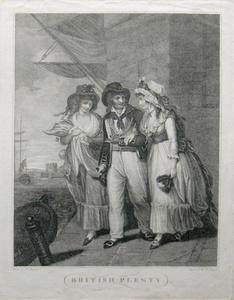| Method | Stipple |
| Artist | P. Vedovato after H. Singleton |
| Published | c. 1794 |
| Dimensions | Image 365 x 290 mm, Plate 435 x 330 mm, Sheet 445 x 340 mm |
| Notes |
This is one of a pair of Singleton prints that contrast British wealth with food shortages in India (the other is entitled 'Scarcity in India). There had been a particularly bad famine in Bengal in 1769-1770. The artist Henry Singleton illustrated Shakespeare's plays and produced sentimental genre scenes with an eye to the print trade. This pair of prints shows sailors on shore leave in pursuit of local girls. They provide particularly clear illustrations of seamen's dress in the 1790s. In contrast with 'Scarcity in India', which shows two men vying for the attentions of one girl, 'British Plenty' shows a single seaman between two girls. They are ostensibly trying to sell him vegetables but their fine dresses indicate that they are prostitutes. One holds a cauliflower and the other a cabbage in her apron. The resemblance between the girls and the vegetables they carry indicates that they themselves are the objects for sale. The right-hand girl is wearing a robe 'à l'anglaise' over a muslin skirt and a large mob cap decorated with ribbons. The left-hand girl has a Leghorn straw hat and a silk shawl. The dress of the seaman is shown particularly clearly. He is in shore-going clothes with baggy wool or cotton trousers cut quite narrowly across the ankles and a blue wool jacket. The white lapels of the jacket are also found on officer's coats of this period. The sleeves have mariner's cuffs outlined with white piping. The cut of his waistcoat reflects contemporary civilian fashions. He has a white, checked shirt in cotton or linen, a tarred straw hat and a coloured silk neckerchief, probably imported from India. He holds a bottle of wine. The location of the scene is probably intended to be Portsmouth although the round tower at the entrance to the harbour is not shown accurately. |
| Framing | unmounted |
| Price | £280.00 |
| Stock ID | 2807 |

